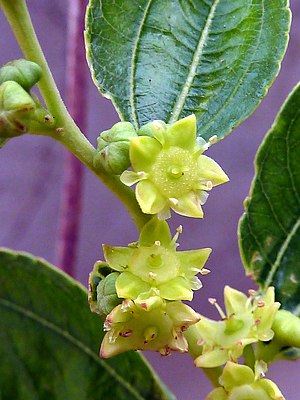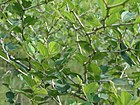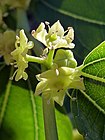Note: This is a project under development. The articles on this wiki are just being initiated and broadly incomplete. You can Help creating new pages.
Ziziphus jujuba
Ziziphus jujuba is a usually spiny, deciduous tree, sometimes only a shrub; it can grow up to 10 metres tall. The tree spreads by root suckers, often forming dense thickets. Jujube was first cultivated as a fruit crop in China before 2,000 BCE.
Contents
[hide]- 1 Uses
- 2 Parts Used
- 3 Chemical Composition
- 4 Common names
- 5 Properties
- 6 Habit
- 7 Identification
- 8 List of Ayurvedic medicine in which the herb is used
- 9 Where to get the saplings
- 10 Mode of Propagation
- 11 How to plant/cultivate
- 12 Commonly seen growing in areas
- 13 Photo Gallery
- 14 References
- 15 External Links
Uses
Chronic fatigue, Loss of appetite, Diarrhoea, Pharyngitis, Bronchitis, Anaemia, Irritability, Hysteria.[1]
Food
Ziziphus jujuba can be used in Food. Unripe fruits are pickled. Ripe fruits are eaten raw. Fruit pulp is dried and stored for future use.[2]
Parts Used
Chemical Composition
It contains alphitolic acid, 3-O-(cis-p-coumaroyl)-alphitolic acid, 3β-O-(trans-p-coumaroyl)-maslinic acid, pomonic acid, 2-oxo-pomolic acid, benthamic acid, terminic acid, oleanic acid etc.[3]
Common names
| Language | Common name |
|---|---|
| Kannada | |
| Hindi | |
| Malayalam | |
| Tamil | |
| Telugu | |
| Marathi | |
| Gujarathi | |
| Punjabi | |
| Kashmiri | |
| Sanskrit | |
| English |
Properties
Reference: Dravya - Substance, Rasa - Taste, Guna - Qualities, Veerya - Potency, Vipaka - Post-digesion effect, Karma - Pharmacological activity, Prabhava - Therepeutics.
Dravya
Rasa
Guna
Veerya
Vipaka
Karma
Prabhava
Nutritional components
Ziziphus jujuba Contains the Following nutritional components like - Vitamin-A, B and C; Calcium, Iron, Magnesium, Phosphorus, Potassium, Sodium[2]
Habit
Identification
Leaf
| Kind | Shape | Feature |
|---|---|---|
Flower
| Type | Size | Color and composition | Stamen | More information |
|---|---|---|---|---|
| {{{5}}} |
Fruit
| Type | Size | Mass | Appearance | Seeds | More information |
|---|---|---|---|---|---|
Other features
List of Ayurvedic medicine in which the herb is used
Where to get the saplings
Mode of Propagation
Seeds, Root cuttings, Cuttings of mature wood.
How to plant/cultivate
Ziziphus jujuba is a very cold tolerant plant with different reports suggesting that it can withstand winter temperatures falling as low as -20 - to -30°c[5]. Ziziphus jujuba is available through September to December[2]
Commonly seen growing in areas
Dry gravelly, Stony slopes of hills, Sunny dry slopes.
Photo Gallery
References
- Jump up ↑ Indian Medicinal Plants by C.P.Khare
- ↑ Jump up to: 2.0 2.1 2.2 "Forest food for Northern region of Western Ghats" by Dr. Mandar N. Datar and Dr. Anuradha S. Upadhye, Page No.153, Published by Maharashtra Association for the Cultivation of Science (MACS) Agharkar Research Institute, Gopal Ganesh Agarkar Road, Pune
- Jump up ↑ Chemical constituents
- Jump up ↑ [Morphology]
- Jump up ↑ Cultivation
External Links
- Ayurvedic Herbs known to be helpful to treat Chronic fatigue
- Ayurvedic Herbs known to be helpful to treat Loss of appetite
- Ayurvedic Herbs known to be helpful to treat Diarrhoea
- Ayurvedic Herbs known to be helpful to treat Pharyngitis
- Ayurvedic Herbs known to be helpful to treat Bronchitis
- Ayurvedic Herbs known to be helpful to treat Anaemia
- Ayurvedic Herbs known to be helpful to treat Irritability
- Ayurvedic Herbs known to be helpful to treat Hysteria
- Herbs with Fruits used in medicine
- Habit - Deciduous tree
- Index of Plants which can be propagated by Seeds
- Index of Plants which can be propagated by Root cuttings
- Index of Plants which can be propagated by Cuttings of mature wood
- Herbs that are commonly seen in the region of Dry gravelly
- Herbs that are commonly seen in the region of Stony slopes of hills
- Herbs that are commonly seen in the region of Sunny dry slopes
- Herbs





